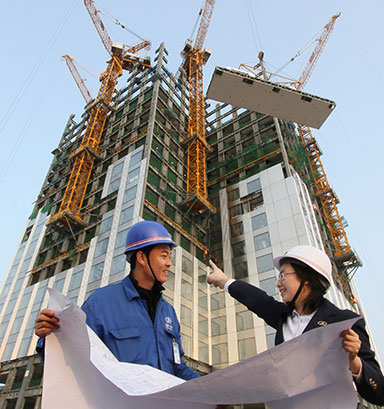More and more discussion is taking place concerning how modular, factory-built construction can address the issues confronting the industry.
The shortage of skilled labour, the importance of increasing efficiency by moving away from bespoke processes and the need for immediate solutions to address housing supply are challenges being faced around the world.
Nowhere is modular construction more remarkable than in China, particularly when it comes to volumetric modular.
According to the Modular Construction Market forecast for 2025 to 2030, the global modular market is projected to grow from US$104 billion to US$131 billion, a CAGR of 4.8 per cent. However, a separate report suggests the CAGR for China’s modular industry will be more than double the projected global growth, increasing by around 10.1 per cent over the same period.
Of course, China can offer enormous industrial scale not possible in Canada. Yet there is more to it than that, and many lessons can be gleaned.
One key factor is the Chinese government’s commitment to construction overall, lately to the tune of more than US$1 trillion. As Fortune Business Insights reports, the government has directed a good portion of this investment towards modular construction by allowing bank loans to be more accessible to prefabrication-based companies, thus encouraging the further development of prefabrication technology, production facilities and distribution networks.

The Chinese government has also created what are called Special Economic Zones (SEZs). These are designated areas within the country that offer tax breaks and relaxed regulations and other special economic incentives to modular factories.
China’s policies are not restricted to Chinese companies. Encouraging foreign investment is part of the Chinese modular equation.
For example, Stack Modular, half-owned by Bird Construction, operates three modular manufacturing operations in China. Finnish-based Peikko Group opened their first Chinese facility in 2011 in the city of Zhangjiagang, north of Shanghai. In 2022, it acquired a major share in China-based prefabricated construction company Shanghai Shucko Construction Technology.
China is using prefabrication to successfully address its shortage of housing supply. Some Chinese companies are even offering prefabricated pod and multi-unit residential buildings for export. However, it is in the larger residential, commercial health care and education sectors where Chinese modular innovation demonstrates global leadership.
During the COVID-19 pandemic, the world became aware of China’s modular expertise as it watched multi-storey medical care units being assembled in days in order to deal with those infected with the virus.
Yet China had been using modular processes for some time prior to COVID. In 2015, Chinese modular construction company BROAD Sustainable Building Co. Ltd, a subsidiary of the Broad Group, assembled a 57-storey, 90 per cent factory-produced LEGO-like modular skyscraper in just 19 days back in 2015.
Broad then developed technology that picked up the speed of modular construction even more. In 2021, the company completed a 10-storey apartment building in 28 hours and 45 minutes. This was not a one-off event. In January 2024, Broad assembled a 26-storey residential tower in only five days.
Key to this rapid construction is Broad’s Holon Building concept that features foldable, container-sized units that utilize stainless steel.
“We transitioned to stainless steel about five years ago,” said Jeremy Zimman, director of marketing at BROAD USA’s New Jersey office. “We realized the mechanical properties of stainless included not only non-corrosion, which is good for facades, but stainless steel also has a great ductility — the ability to withstand tensile stress.”
Such tall buildings built with increasing speed are the result of remarkable developments in modular construction, as described by Finnish construction innovator Aarni Heiskanen in a recent article.
One such innovation is called the Intelligent Micro Bump Jacking Formwork System, essentially a modular factory-in-the-sky was used to assemble a 108-storey tower in Beijing. Another is the Design-Prefabricate-Transport-Assemble model. Theses processes were born out of necessity due to the heights of China’s skylines which are making formwork systems inefficient and unsafe.
Scale, innovation and massive government support have made modular construction successful in China. Perhaps some of these key elements can be recreated and adopted in North America.
John Bleasby is a freelance writer. Send comments and Inside Innovation column ideas to editor@dailycommercialnews.com.





Recent Comments